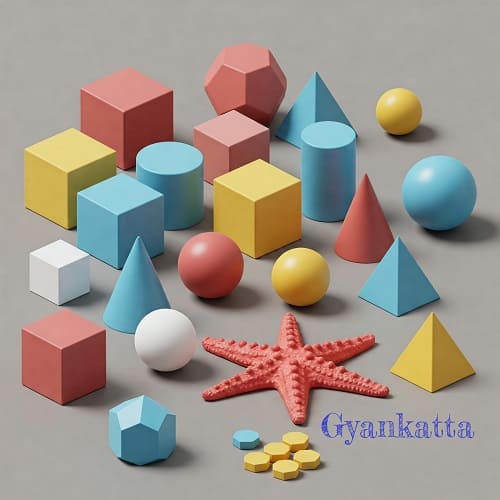Practical Geometry – Class 8
Hi everyone! This chapter is all about Practical Geometry. We’ll learn how to construct different quadrilaterals (four-sided figures) using a ruler, compass, and protractor.
What is Construction?
Geometric construction involves drawing shapes and figures using precise tools and following specific steps. We’ll be focusing on constructing quadrilaterals.
Constructing Quadrilaterals
To construct a unique quadrilateral, you’ll generally need five pieces of information. This information might include:
- Lengths of four sides and one diagonal
- Lengths of three sides and two diagonals
- Lengths of two adjacent sides and three angles
- Lengths of three sides and the two included angles
- When special properties are given (like a square or rhombus)
Let’s look at some examples:
1. Constructing a Quadrilateral When Four Sides and One Diagonal are Given:
Construct quadrilateral ABCD where AB = 4 cm, BC = 5 cm, CD = 6 cm, DA = 5 cm and AC = 7 cm.
- Draw side AB = 4 cm.
- With A as center and radius 7 cm (diagonal AC), draw an arc.
- With B as center and radius 5 cm (side BC), draw another arc intersecting the previous arc at C.
- With C as center and radius 6 cm (side CD), draw an arc.
- With A as center and radius 5 cm (side DA), draw another arc intersecting the previous arc at D.
- Join AC, BC, CD, and DA.
2. Constructing a Quadrilateral When Three Sides and Two Diagonals are Given:
Construct quadrilateral PQRS where PQ = 4cm, QR = 6cm, RS = 5cm, PR = 7cm and QS = 8cm.
- Draw side PQ = 4cm.
- With P as center and radius 7cm (diagonal PR), draw an arc.
- With Q as center and radius 8cm (diagonal QS), draw another arc intersecting the previous arc at R.
- With Q as center and radius 6cm (side QR), draw an arc.
- With R as center and radius 5cm (side RS), draw another arc intersecting the previous arc at S.
- Join PR, QR, QS, RS, and SP.
(Diagram would be here)
3. Constructing a Parallelogram when Two Adjacent Sides and One Angle are given.
Construct parallelogram ABCD where AB = 5cm, BC = 4cm and ∠B = 60°.
- Draw AB = 5cm.
- At B, construct ∠B = 60°.
- Along the ray of ∠B, mark BC = 4cm.
- With A as center and radius 4cm, draw an arc.
- With C as center and radius 5cm, draw an arc intersecting the previous arc at D.
- Join AD and CD.
(Diagram would be here)
Tips for Construction
- Use sharp pencils for accurate drawings.
- Measure lengths and angles carefully.
- Follow the steps in the correct order.
- Practice makes perfect!
Applications of Practical Geometry
1. Engineering and Architecture:
Creating blueprints and technical drawings.
2. Design and Art:
Creating patterns, designing graphics.
3. Construction:
Laying out building plans.
Practical geometry is a valuable skill for many fields and helps develop spatial reasoning.
Practical Geometry Quiz – Tough Application Problems
1. Parallelogram Construction: Construct a parallelogram ABCD where AB = 6 cm, BC = 4 cm, and angle B = 75 degrees. What is the length of diagonal AC?
2. Rhombus Construction: Construct a rhombus PQRS where PR = 8 cm and QS = 6 cm. What is the length of each side of the rhombus?
3. Rectangle Construction: Construct a rectangle ABCD where AB = 5 cm and AC = 7 cm. What is the length of BC?
4. Square Construction: Construct a square ABCD where the diagonal AC = 6 cm. What is the length of each side of the square?
5. Quadrilateral with Specific Angles: Construct quadrilateral ABCD where AB = 4 cm, BC = 5 cm, angle A = 90 degrees, and angle B = 110 degrees. What is the measure of angle C?
6. Trapezium Construction: Construct trapezium ABCD where AB is parallel to CD, AB = 8 cm, BC = 5 cm, CD = 4 cm, and AD = 6 cm. What is the height of the trapezium? (This requires additional construction)
7. Kite Construction: Construct kite ABCD where AB = AD = 5 cm and BC = CD = 7 cm. Measure the length of the diagonals AC and BD.
8. Cyclic Quadrilateral Construction: Construct a cyclic quadrilateral ABCD where AB = 4 cm, BC = 5 cm, CD = 6 cm, and AD = 3 cm. What is the sum of angles A and C?
9. Constructing a Quadrilateral with Given Angles and Sides: Construct a quadrilateral ABCD where AB = 4 cm, ∠A = 60°, ∠B = 90°, BC = 5 cm and ∠C = 120°. Measure the length of AD.
10. Area Calculation (Post Construction): Construct a rectangle ABCD with AB = 6cm and BC = 4cm. Calculate its area and verify by measuring the dimensions after construction.
